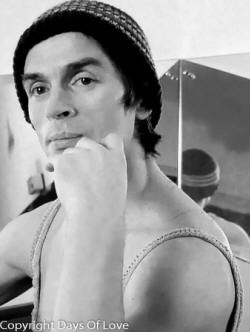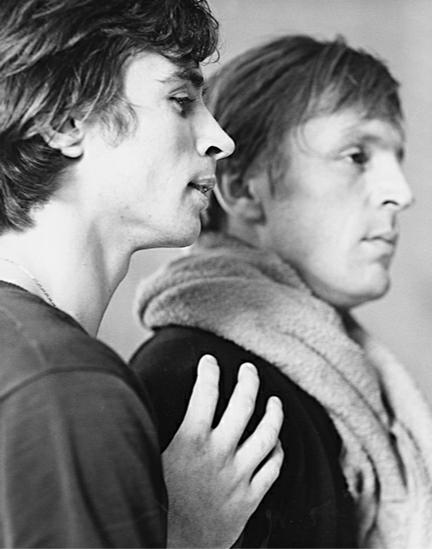

Partner Erik Bruhn
Queer Places:
Mariinsky Theatre, Theatre Square, 1, Sankt-Peterburg, Russia, 190000
Vaganova Academy of Russian Ballet, Ulitsa Zodchego Rossi, 2, Sankt-Peterburg, Russia, 191023
Dakota Apartments, 1 W 72nd St, New York, NY 10023, Stati Uniti
6 Fife Rd, London SW14 7EP, Regno Unito
Sainte-Geneviève-des-Bois Russian Cemetery, 4 Rue Léo Lagrange, 91700 Sainte-Geneviève-des-Bois, Francia
 Rudolf Khametovich Nureyev (17 March 1938 – 6 January 1993) was a Soviet
ballet dancer and choreographer. He was director of the Paris Opera Ballet
from 1983 to 1989 and its chief choreographer until October 1992.
Rudolf Khametovich Nureyev (17 March 1938 – 6 January 1993) was a Soviet
ballet dancer and choreographer. He was director of the Paris Opera Ballet
from 1983 to 1989 and its chief choreographer until October 1992.
Named Lord of the Dance,[1][2][3] Nureyev is regarded as one of ballet's most gifted male dancers.[1][4][5][6]
In addition to his technical prowess, Rudolf Nureyev was an accomplished choreographer. He produced his own interpretations of numerous classical works,[7] including Swan Lake, Giselle, and La Bayadère.[8]
Nureyev had his early career with the Mariinsky Ballet in St. Petersburg. On 11 May 1961 Rudolf Nureyev began his famous trip to Paris with the Kirov. In the evenings he kept wandering off, without permission, with a group from the Paris Opéra Ballet. Among other treats, they took him to see West Side Story. A bisexual English fan, Michael Wishart, also took him several times to visit the Louvre. On 3 June Moscow ran out of patience with the young dancer and ordered his immediate recall. He defected from the Soviet Union to the West, despite KGB efforts to stop him.[9] This was the first defection of a Soviet artist during the Cold War and it created an international sensation.
Two of the people he most wanted to meet in the West were the choreographer George Balanchine and the best of the classical dancers, Erik Bruhn. When he happened to meet the American ballerina Maria Tallchief, once Balanchine’s third wife and more recently Bruhn’s lover, this became possible. Tallchief took him to Copenhagen to meet Bruhn, and before long Nureyev had fallen in love. (Nureyev was twenty-three, Bruhn thirty-two.) A friend later said, ‘I doubt Rudolf ever knew he was homosexual until he met Erik.’ Nureyev moved in with Bruhn and his mother. (The two men had separate bedrooms.) Nureyev and Bruhn’s mother soon learned to hate each other.

Rudolf Nureyev and Erik Bruhn
Dakota Apartments, 1 W 72nd St, New York, NY 10023, Stati Uniti
Depending on the source, Nureyev is described as either bisexual,[58][59] as he did have heterosexual relationships as a younger man, or gay.[60][61][62] He had a turbulent sex life, with numerous bathhouse visits and anonymous pickups.[54] Nureyev met Erik Bruhn, the celebrated Danish dancer, after Nureyev defected to the West in 1961. Nureyev was a great admirer of Bruhn, having seen filmed performances of the Dane on tour in the Soviet Union with the American Ballet Theatre, although stylistically the two dancers were very different. Bruhn and Nureyev became a couple[60][63] and the two remained together off and on, with a very volatile relationship for 25 years, until Bruhn's death in 1986.[64]
Nureyev made his London debut at the Theatre Royal, Drury Lane, on 2 November 1961. In a gala organised by Margot Fonteyn, Nijinsky’s four-minute Feux d’artifice, choreographed by Frederick Ashton, gave the audience more than the thrill they had hoped for. Lady Diana Cooper whispered to Cecil Beaton, ‘He’s better than Nijinsky!’ To Beaton, he was ‘a savage young creature, half naked, rushing with wild eyes on an ecstatic, gaunt face, and a long mop of flying, silk hair’.
Nureyev first arrived in New York on 15 January 1962. He asked if he could join the New York City Ballet, but George Balanchine was not interested. He told the boy, ‘You don’t know how to dance the way we dance and it would take you too long to learn.’ When Nureyev protested to the contrary, Balanchine said, ‘No, no, go and dance your princes, and then when you’re tired, you come back to me.’
In 1963 Christopher Gable became Nureyev’s closest rival in the Royal Ballet. Along with Lynne Seymour they danced a threesome based on Shakespeare’s sonnet 144, ‘Two loves I have, of comfort and despair’, with Gable, as Comfort, and Seymour, as Despair, struggling for possession of Nureyev.
In 1968 Frederick Ashton commissioned Derek Jarman to design a ballet, Jazz Calendar, to a score by Richard Rodney Bennett; Nureyev would dance one of its seven segments with Antoinette Sibley when it was premiered in January 1968.
On Christmas Day 1968 Nureyev opened in Rudi van Dantzig’s Monument for a Dead Boy – about a boy becoming gay – with the Dutch National Ballet in The Hague. He then persuaded the Royal Ballet in London to commission van Dantzig to choreograph a new ballet, The Ropes of Time, which was premiered on 2 March 1970. In that year, there were plans for a film about Nijinsky – to be played by Nureyev – written by Edward Albee, to be directed by Tony Richardson. It would include a performance of Jeux as first intended, danced by three men. The project failed for lack of funding; and the funding had failed, according to van Dantzig, because the producers were ‘worried about showing a ballet about three men’.
He socialized with Gore Vidal, Freddie Mercury, Jackie Kennedy Onassis, Mick Jagger, Liza Minnelli, Andy Warhol, Lee Radziwill and Talitha Pol, and occasionally visited the legendary New York discotheque Studio 54 in the late 1970s, but developed an intolerance for celebrities.[55] He kept up old friendships in and out of the ballet world for decades, and was considered to be a loyal and generous friend.[56]
In 1973 Nureyev met the 23-year-old American dancer Robert Tracy and a two-and-a-half-year love affair began. Tracy later became Nureyev's secretary and live-in companion. According to Tracy, Nureyev said that he had had sex with three women in his life, he had always wanted a son, and once had plans to father one with Nastassja Kinski.[49]
When AIDS appeared in France's news around 1982, Nureyev took little notice. The dancer tested positive for HIV in 1984, but for several years he simply denied that anything was wrong with his health. However, by the late 1980s his diminished capabilities disappointed his admirers who had fond memories of his outstanding prowess and skill.[65] Nureyev began a marked decline only in the summer of 1991 and entered the final phase of the disease in the spring of 1992.[66]
He went on to dance with The Royal Ballet in London and from 1983 to 1989 served as director of the Paris Opera Ballet.
In March 1992, living with advanced AIDS, he visited Kazan and appeared as a conductor in front of the audience at Musa Cälil Tatar Academic Opera and Ballet Theater, which now presents the Rudolf Nureyev Festival in Tatarstan.[67][68] Returning to Paris, with a high fever, he was admitted to the hospital Notre Dame du Perpétuel Secours in Levallois-Perret, a suburb northwest of Paris, and was operated on for pericarditis, an inflammation of the membranous sac around the heart. At that time, what inspired him to fight his illness was the hope that he could fulfill an invitation to conduct Prokofiev's Romeo and Juliet at an American Ballet Theatre benefit on 6 May 1992 at the Metropolitan Opera House in New York. He did so and was elated at the reception.[66]
In July 1992, Nureyev showed renewed signs of pericarditis but determined to forswear further treatment. His last public appearance was on 8 October 1992, at the premiere at Palais Garnier of a new production of La Bayadère that he choreographed after Marius Petipa for the Paris Opera Ballet. Nureyev had managed to obtain a photocopy of the original score by Minkus when in Russia in 1989.[69] The ballet was a personal triumph although the gravity of his condition was evident. The French Culture Minister, Jack Lang, presented him that evening on stage with France's highest cultural award, the Commandeur de l'Ordre des Arts et des Lettres.[66]
Nureyev re-entered the hospital Notre Dame du Perpétuel Secours in Levallois-Perret on 20 November 1992 and remained there until his death from cardiac complications at age 54 on 6 January 1993. His funeral was held in the marble foyer of the Paris Garnier Opera House. Many paid tributes to his brilliance as a dancer. One such tribute came from Oleg Vinogradov of the Mariinsky Ballet in Saint Petersburg, Russia, stating: "What Nureyev did in the west, he could never have done here."[70]
Nureyev's grave, at a Russian cemetery in Sainte-Geneviève-des-Bois near Paris, features a tomb draped in a mosaic of an oriental carpet. Nureyev was an avid collector of beautiful carpets and antique textiles.[66][67][71] As his coffin was lowered into the ground, music from the last act of Giselle was played and his ballet shoes were cast into the grave along with white lilies.[72]
Rudolf Nureyev did not have much patience with rules, limitations and hierarchical order and had at times a volatile temper.[53] He was apt to throw tantrums in public when frustrated.[54] His impatience mainly showed itself when the failings of others interfered with his work.
Most ballerinas with whom Rudolf Nureyev danced, including Antoinette Sibley, Gelsey Kirkland and Annette Page paid tribute to him as a considerate partner. He was known as extremely generous to many ballerinas, who credit him with helping them during difficult times. In particular, the Canadian ballerina Lynn Seymour – distressed when she was denied the opportunity to premiere MacMillan's Romeo and Juliet – says that Nureyev often found projects for her even when she was suffering from weight issues and depression and thus had trouble finding roles.[57]
After so many years of having been denied a place in the Mariinsky Ballet history, Nureyev's reputation was restored.[70] His name was reentered in the history of the Mariinsky and some of his personal effects were placed on display at the theatre museum in St. Petersburg.[70] At the famed Vaganova Academy a rehearsal room was named in his honour.[70]
At the Paris Opera there is a tradition to organize a dance night as homage to Rudolf Nureyev every ten years after he died in 1993. The homage to Nureyev was scheduled on 20 March 2003 and on 6 March 2013 respectively because he was born in March.[75] Peers of Rudolf Nureyev speaking about him and remembering him like Mikhail Baryshnikov are often deeply touched.[46][76]
As of October 2013, the Centre National du Costume de Scene has a permanent collection of Nureyev's costumes "that offers visitors a sense of his exuberant, vagabond personality and passion for all that was rare and beautiful."[73]
In 2015, he was inducted into the Legacy Walk.[74]
My published books: